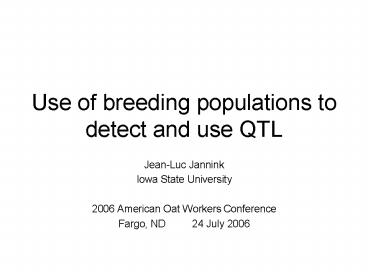Use of breeding populations to detect and use QTL
1 / 27
Title:
Use of breeding populations to detect and use QTL
Description:
Mutation Subpopulation structure / admixture Structure Analysis Given Structure Each individual has a probability of belonging to each subpopulation: ... –
Number of Views:57
Avg rating:3.0/5.0
Title: Use of breeding populations to detect and use QTL
1
Use of breeding populations to detect and use QTL
- Jean-Luc Jannink
- Iowa State University
- 2006 American Oat Workers Conference
- Fargo, ND 24 July 2006
2
Translation
ExperimentalPopulations
3
Bi-parental cross
From Schön et al., yield, plant height, and grain
moisture all over here
4
Community Effort Needed
- The number of effective factors influencing a
highly quantitative trait (e.g., grain yield)
probably gt50. - Number of individuals needed to identify such
small-effect QTL probably 1000.
5
http//www.barleycap.org
Objective Capitalize on phenotyping in breeding
programs
6
Barley CAP
7
QTL Detection in Breeding Populations
- P E G
- P E M u
8
Requirement of Linkage Disequilibrium
- A specific typed marker allele always comes
together with the same causal QTL allele - This is Linkage Disequilibrium
- Under what conditions does this occur?
9
Mutation
Original Population State
aB
AB
AB
aB
AB
aB
aB
AB
The b allele now always occurs in the presence of
the A allele
10
Subpopulation structure / admixture
Population 1
a B
B A
B A
a B
A B
B a
a B
A B
11
Structure
12
Analysis Given Structure
- Each individual has a probability of belonging to
each subpopulation Q - Each subpopulation has its own mean, vk
- But only one effect is associated with each
allele, ?
13
QTL x E?
Dry
Wet
QTL x E x Structure?
14
Barley CAP
15
Possible Use
16
Key Question
- What level of LD exists in the American Oat
Population? - To detect causal polymorphisms, they need to be
in high LD (r2 gt 0.5) with typed polymorphisms. - If (r2 gt 0.5) extends over several cM, we will
need fewer markers
17
LD in European barley
There were in total 53 marker pairs with
distance lt 1 cM, of which 32 had a significant
correlation (P lt 0.01), while 19 pairs were not
significantly correlated (P gt 0.01) and thus in
LE.
N.B. r2gt0.06 gt P lt 0.01, whereas r2gt0.50 needed
18
Linkage Disequilibrium
19
LD in North American Oat
- ODonoughue et al. 1994 Relationships among
North American Oat Cultivars Based on Restriction
Fragment Length Polymorphisms - 83 cultivars (both spring and winter)
- 48 probes
- 205 polymorphic bands
20
Extended data from Sorrells
- 56 Probes
- 239 Polymorphic bands (alleles)
- 28441 allele pairs
21
Distribution of r2
22
Linkage Disequilibrium
23
Extended data from Sorrells
- 56 Probes
- 40 Probes with position on KxO (Wight 2003)
- 21 Probes with a single position on KxO
- 8 Probe pairs with single location on same
linkage group
24
LD in North American Oat
25
Questions for DArT markers
- Likely to be biased toward transcribed /
untranscribed genomic regions? - What minor allele frequencies does the discovery
process allow? - Will they mark only a single location in the
hexaploid genome? - We should probably be able to use the discovery /
diversity panel for an LD study
26
Conclusion
- I think LD-based MAS has promise
- integrated discovery and use of QTL
- capitalizes on phenotyping by breeders
- I think we are already setting up the DArT marker
discovery process so as to get a first estimate
of feasibility in oat.
27
LD decay over time































